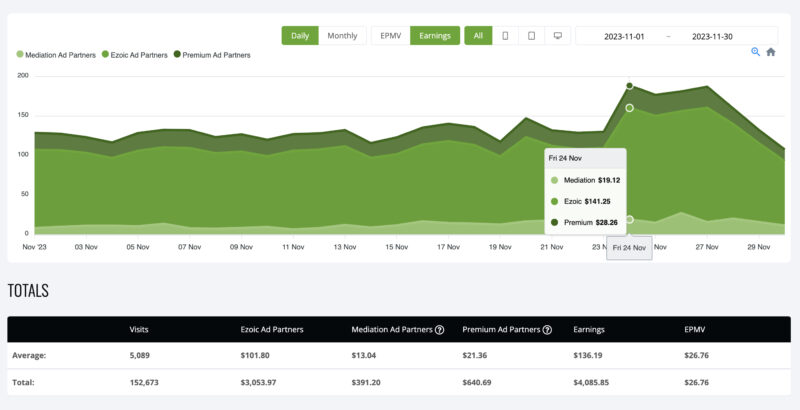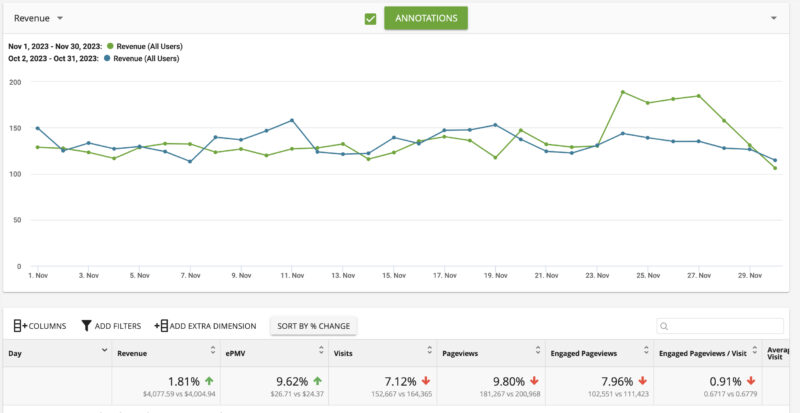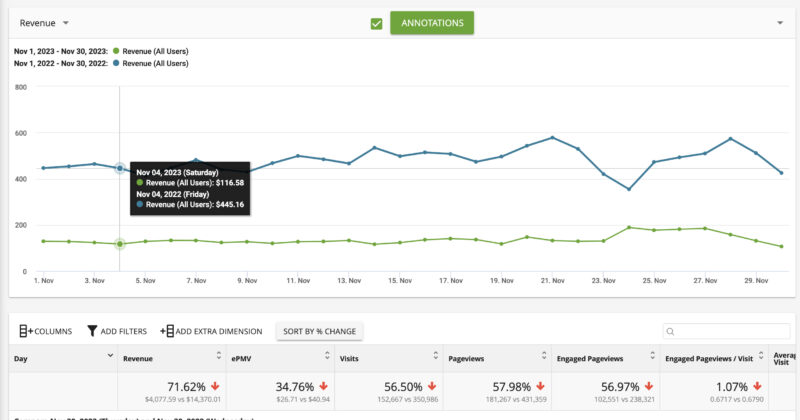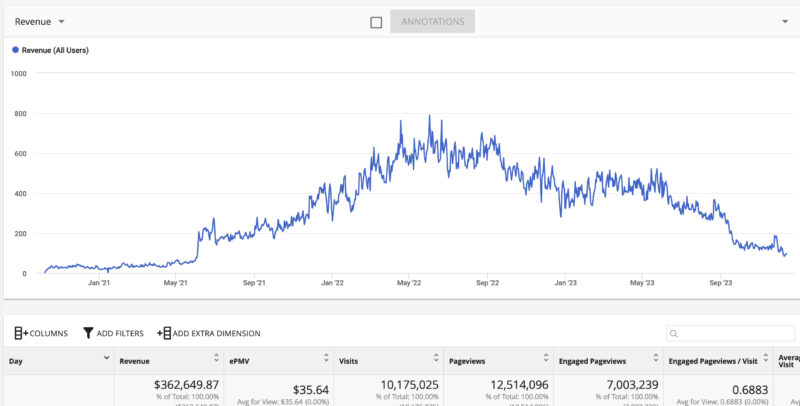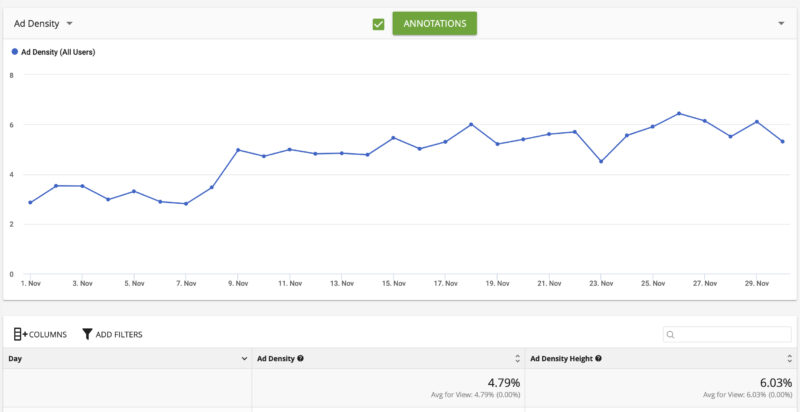Google’s newest Core Updates and changes to their algorithm continue to baffle and frustrate publishers all around the world, including us. While I’d normally just say “It is what it is”, that still doesn’t change the fact that our case study domain continues to bleed site traffic and organic search volume, just as our end-year ad revenues dip to a new low of $4,077 as of November 2023, the lowest in the last 2.5 years.
If you’re keen to see just how we got here, you could check out that handy-handy Revenue Reports tab up top for a month-by-month check-up on how much our case study domain has been earning. TL;DR, if we’d compare it against our metrics for last month (October 2023), ad earnings rose by about 1.81% ($4,077 vs $4,005), whereas EPMVs (earnings per thousand visitors) went up by around 9.62% ($26.71 vs $24.37).
On the other hand, this didn’t really help to offset the roughly ~7.12% (down to 152,667), ~9.80% (now at 181,267), and ~7.96% (declined to 102,551) drop-offs across the board, respectively, when it came down to our case study domain’s page visits, pageviews, and ‘engaged’ pageviews. Thankfully, this was made a tad better thanks to Ezoic’s (our preferred ad network provider) Premium program and its many perks.
Among those goodies was the fact that Ezoic’s premium ad partners could display ads on our case study domain, earning us more compared to Ezoic’s regular ad partners. These higher-paying ad partners were able to buck up our would-be ad earnings by another $641. Meanwhile, having Ezoic’s Mediation system turned on and allowing alternative monetization from other ad networks gained us another $391.
| November 2023 Ad Revenue From Ezoic | ||
|---|---|---|
| Revenue (Total) | $4,077 | |
| Traffic | Visits | 152,667 |
| Pageviews | 181,267 | |
| Engaged Pageviews | 102,551 | |
| ePMV (Earnings Per Thousand Visitors) | $26.71 | |
Many Challenges Lay Ahead
Nonetheless, while I’m braced and prepared for what lies ahead, it’s still astounding when you compare it against what our case study domain was earning a year ago. Our ad revenue cratered by ~71.62% (only a year ago, we were earning around $14,370 back in November 2022). Furthermore, page visits, pageviews, and engaged pageviews also declined anywhere between 56% to 58% respectively, year on year.
Granted, EPMVs (not something regular publishers like us can easily change), had declined by ~34.76% in just a year, too. The one consolation that I could take away from this, is that every other publisher in that same niche as us also suffered greatly thanks to Google’s recently updated search engine algorithm. That means a lot of them are seeing similar declines in traffic and ad revenue, and in some cases, worse off.
Another bit of good news is that, while Google’s algorithms are shifting, the fundamentals of making and sharing good content remain the same. So, if you’d like to learn how you too can get started, or if you’re thinking of refining your content creation process, consider checking out my training course. Furthermore, I’ve previously discussed the importance of keyword research, even with Google’s updated guidelines.
That includes our comprehensive guide and overview of how to do good keyword research, as well as our on-page SEO checklist, and our list of the best free keyword research tools. It’s these fundamentals that contributed to our case study domain, through a challenging 2023, to still have raked in over $363k in ad revenues since we started, as well as more than 10+ million page visits and 12+ million pageviews.
Google’s Helpful Content Update (HCU)
As such, if you’d like to learn how you too can replicate our case study domain’s success, you could check out my in-depth analysis and insights into making money online from content creation websites, which is also free! And, if you want to make the most out of lost traffic or revenues as much as you can, check out our guide on how to optimize Ezoic for maximum ad revenue and how to get started with Ezoic today.
This isn’t to say that we’ve been sitting idle this whole time, just waiting for Google’s algorithms to correct itself, either. We have been making quite a lot of changes to our content creation process, just to optimize for Google’s latest Helpful Content Update (HCU) guidelines. For those who might’ve missed it, this is a big new update to its search engine that now primarily prioritizes short, concise, helpful, user-first content.
This isn’t to say that our older content wasn’t somehow people-first or isn’t helpful in any way, but it’s quite clear now that the way we’ve learned how to game and maximize SEO through keyword usage or internal linking isn’t as effective anymore. Therefore, it’s massively shaken up our usual formatting and content styles to suit this new change. In fact, Google’s HCU has been around for a while now, since around Q4 of 2022.
You could even see it in that graph earlier on our to-date ad revenues, that our case study domain saw a lot of stagnation sometime in late Q3 2022, before dropping off gradually through to Q3 2023. Alas, this wasn’t until Google’s HCU guidelines really took into effect on September 2023, which is where our case study domain began tanking hard, and to this day, the outlook for a recovery remains rather dim.
What Changes Are We Making?
So, you might be asking… Why didn’t we adapt and make changes to our case study domain any sooner, back in late 2022? Well, the answer is quite simple; we got blindsided by Google. They introduced HCU in the most subtle way possible, and it wasn’t until September 2023 or thereabouts that it was made super clear what was happening, and it wasn’t until then that a proper explanation or guideline was set out.
Consequently, most other publishers scrambled to figure out what was going on, and to this day, very few have it figured out. Even dedicated, professional SEOs weren’t expecting how radical and disruptive it was. From what I’ve learned though, I did gather some insights that might prove helpful. Firstly, if your site has suffered a major drop in site traffic and ad revenue, your domain might’ve been applied a site classifier.
This is Google’s way of classifying which sites are more helpful than others or which sites aren’t helpful. It has since resulted in sites with a lot of user-generated content, like Reddit, Quora, or other online forums and discussion sites witnessing an explosion of new traffic. Additionally, Google now appears to prioritize content that’s made for and built toward actual human users, rather than optimized solely for search engines.
In other words, the gaming of search engines and the elaborate SEO processes that we’ve developed over the past couple of years no longer work in Google’s eyes. Moreover, the user experience of your site also matters a lot, which is another area that I’ve been fixated on. I’ve since optimized the case study domain’s home page, the user interface on mobile devices, and ad layout optimization, and even reduced the ad density.
Video Overview
With all these UI and UX changes, my hope is that with a cleaner and slicker user interface, users, as well as Google’s Quality Raters, might view our case study domain more favorably. Aside from that, and this is something we’ve discussed in our previous monthly reports, but I’ve also fleshed out detailed author pages, so that we can better align ourselves with Google’s EEAT principles when it comes to our authors.
This mainly includes showcasing that an individual author has shown a good amount of experience, and expertise, as well as trustworthiness and authoritativeness when discussing a particular subject or niche. For now, though, all we’re going to do next is keep our heads down and keep on keeping on, pushing out good content as per usual, and see how it goes from here before we commit to any major changes.
If you’d like to learn more and catch up on some things that happened last month (November) that I may have omitted here, check out this video down below…


